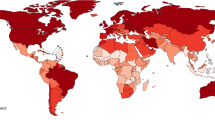Abstract
Background: A cross-sectional survey was conducted in Pelotas, southern Brazil, to assess the relationship between the use of benzodiazepines (BZD), minor psychiatric disorders (MPD) and social factors. Methods: A representative sample (n = 1277) was interviewed using the Self-Reporting Questionnaire (SRQ-20) for MPD. Subjects were asked about the use of BZD in the preceding 2 weeks and were also asked for socioeconomic details. Results: A total of 152 (11.9%; 95% CI 10.1–13.7) subjects had taken psychotropic drugs, with BZD being the most commonly reported (8%). The prevalence of MPD was 22.7% (95% CI 20.4–25.0): males 17.9% and females 26.5%. An inverse relationship was seen between level of income, schooling and prevalence of MPD (P < 0.001), but a positive relationship was found between income and BZD consumption (P < 0.05). Conclusions: These data suggest that the inverse care law operates in prescribing psychotropic medications for MPD.
Similar content being viewed by others
Author information
Authors and Affiliations
Additional information
Accepted: 15 February 1999
Rights and permissions
About this article
Cite this article
De Lima, M., Hotopf, M., Mari, J. et al. Psychiatric disorder and the use of benzodiazepines: an example of the inverse care law from Brazil. Soc Psychiatry Psychiatr Epidemiol 34, 316–322 (1999). https://doi.org/10.1007/s001270050150
Issue Date:
DOI: https://doi.org/10.1007/s001270050150




